In recent decades, the search for alternative energies has become increasingly important to the average citizen. Whether it’s due to concerns for the environment or worries about shortages in fuel or rising prices, most people agree that other options need to be found. Considering the amazing amount of energy that is showered down upon us everyday from the sun, it’s no wonder that a lot of research and development is focused on improving our capabilities of capturing this source for electricity generation. As a major bonus solar power is also a renewable energy source that produces no polluting emissions or safety concerns [1].
Although there’s been a lot of fuss about it recently, solar power is not a new fascination. History is filled with stories of mankind searching for ways to harness the sun’s energy. About 700 BC, curved “burning” mirrors were used by Chinese to start fires [2]. By the 16th century, Leonardo Da Vinci had proposed that a very large curved mirror could be used boil water [3,4]. In the 1860s, August Mouchet constructed the first solar powered engine [3,5]. Interestingly, way back in 1913, a solar powered water pumping station was made by Frank Shuman in Egypt (see photo below) [2,3]. It was capable of pumping 6000 gallons of water a minute [3]. Today, there are many uses for solar energy, however a large focus is upon producing electricity.
At present there are two main methods used to capture solar energy and convert it to electricity. One way is by using photovoltaic power and the other is with solar thermal power [2]. When most people think of solar power, they are usually thinking of photovoltaic power, also known as PV for short. PV panels are able to directly convert sunlight into energy [6]. These are the sort of solar panels that you often see on peoples homes and can buy at hardware stores like Home Depot. Unlike photovoltaic power cells, solar thermal power (also known as concentrated solar power) does not directly produce electric power [1,2]. Instead, it produces heat [1]. However, this heat can be captured and changed into electricity [1,2]. In most solar thermal power plants, sunlight is concentrated to heat a fluid, such as oil or liquid salt, which is then used to heat water to create steam [1,2]. The steam is then used to turn a turbine which generates electricity [2].
Photovoltaic power has many advantages, such as the ability to operate on a very small scale or unattended [2], which has likely led to its vast popularity. However, when it comes to large scale productions of electricity, PV is much more expensive than solar thermal power [2]. Thus, this article will review the ways in which solar thermal energy is used for power generation.
Types of Solar Thermal Power Stations
A wide variety of solar thermal power stations are currently being explored. They most notably vary in the way that they concentrate the sunlight, and in what material they use to retain the heat produced.
Parabolic Trough Design
Parabolic trough power plants use a long curved trough which is designed to focus sunlight onto a pipe that runs down the length of the trough in the centre (see photos below) [2,7]. Typically, the troughs are made of thick glass silver mirrors, but can also be made from thin glass, plastic films, polished metals [7]. The pipe, called a receiver, is surrounded by a glass envelope which has a special coating to help maximize energy collection and minimize heat loss [7]. A substance passes through the receiver and is heated by the reflected sunlight that is concentrated on it [7]. This substance is usually a synthetic oil or brine [8]. An example is Abengoa Solar’s parabolic troughs which can heat oil in the receiver to 400°C [7]. The fluid flows to a power block where its heat is used to create high pressure steam [2,7]. This steam drives a conventional steam turbine to produce electricity [2,7].

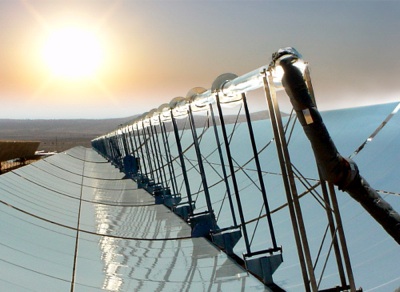
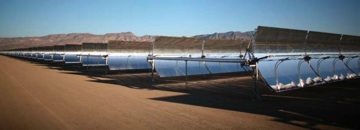
In order the follow the sun as it crosses the sky, the trough moves about a single axis that runs its length [7]. An electronic control system ensures that the reflectors are facing in the optimum direction for maximum solar reflection [7].
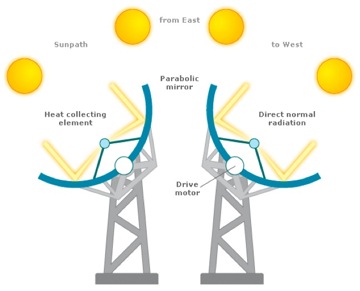
Parabolic trough power plants are the most mature design of concentrated thermal power plants used for commercial use [2,7]. Solar Energy Generating Systems is a series of nine such power facilities that were installed in the 1980s in the Mojave Desert, USA [2,7]. These have a combined total capacity of about 350 MW (MW = megawatts = one million watts) [2]. In comparison, the world’s largest operational photovoltaic power plant only has a capacity of 20 MW [9]. Currently, only one other parabolic trough power plant is operational which is in Nevada [10,11]. However, Spain is constructing several such facilities at present [11]. One of these should be complete by mid-2008 [11]. Many other plants have been announced for a variety of locations around the world including the USA, Egypt, and Algeria [11].
Fresnel Reflector Design
The fresnel reflector power plants have a very similar design to the parabolic trough. Like the parabolic design, a series of long mirrors focus light onto a pipe (the receiver) that runs their length [2]. The main differences are that the mirrors are flat or only slightly curved, and that many rows of mirrors focus onto one receiver [2].

Electricity is produced in the same fashion as the parabolic troughs. The liquid in the receiver is heated and this heat used to produce steam for a steam turbine electricity generator [2]. Ausra, a leading company in this technology, uses water as the fluid in its receivers [2]. Here is a depiction of how Ausra’s fresnel reflector power plant works [2]:

One advantage to this design is that a lot of cost is saved by using simple flat mirrors [2]. The mirrors are also kept close to the ground which reduces wind loads and steel usage [2]. Like the parabolic design, it is kept simple by only needing to rotate around one axis to track the sun [2].
There are currently no commercial solar fresnel reflector power plants [11]. However, Ausra has made a deal with California for a power plant using such technology [12]. It is planned to start operating in 2010 and will have a final capacity of 177 MW [12]. Ausra also has a deal with Florida to provide a similar plant with a 300 MW capacity [12].
In the power tower design, a collection of flat mirrors called heliostats reflect sunlight onto a central tower (see image below) [1,13]. Currently, most heliostats are glass mirrors, although other reflective surfaces can be used [13]. Just like with the parabolic trough design, sunlight is concentrated onto a receiver [1,13]. The difference is that this receiver is on a tower [13]. In most towers, the receiver transfers heat to a fluid, such as molten salt or water [1,13]. By heating fluid, it is possible to move the heat to another section of the concentrated solar plant where it can be used to heat water and thus generate steam [1,13]. The steam moves a turbine to generate electricity [1,13].

A power tower plant that is planned for Cloncurry, Australia has one noted difference in how it will generate steam to the other tower designs [14]. Instead of transferring heat to a fluid, they are planning for the receiver to heat graphite blocks in the tower [14]. Water will then be passed through the graphite blocks to produce steam [14].
There are several advantages to the power tower design. One advantage is that by concentrating all of the sunlight to one location they are able to get very high temperatures (the sunlight is concentrated up to 600 times) [13]. Interestingly, higher temperatures are converted to electricity more efficiently than lower temperatures, so this mean less energy loss [13]. The other advantage compared to the parabolic trough and fresnel reflector designs is that it requires less space [13].
However, one disadvantage to power towers is the fact that each of the heliostats needs to be able to move around two axes in order to reflect sunlight properly onto the receiver. This is unlike the parabolic trough and fresnel reflector designs which can have many mirrors rotate together along one axis. As a result, the power tower requires more foundations and positioning motors [2].

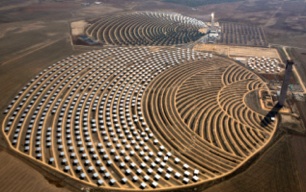
Dish Design
The solar dish design is relatively new and quite different from the other concentrated solar power designs due to the fact that it usually doesn’t use steam and a turbine to produce electricity. Instead, a reflective disc that is similar to the shape of a satellite dish, focuses sunlight onto something called a Stirling engine [17]. The engine is positioned in front of the reflective dish by an arm attached to the dish (see images below). This is a very unique non-combustible engine that functions by using temperature differences [17]. The Stirling engine has a fixed amount of gas sealed within [18]. Heating one end of the Stirling engine with concentrated sunlight creates a large temperature difference from the opposite end of the engine [17,18]. Therefore, the hot temperature at one end causes the gas to expand and move towards the cooler end [18]. As a result, the gases flow within the engine chamber, which in turn makes the engine run [18]. The Stirling engines can then be used to create electricity [18].


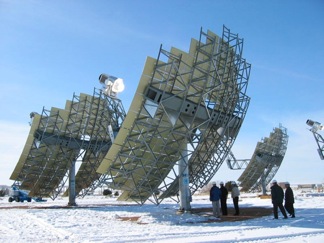
At present, there are no large scale solar dish power plants [11]. However, Stirling Energy Systems and Southern California Edison have signed a 20 year contract that will eventually supply a capacity of 500 MW, with potential further expansion [19]. Stirling Energy Systems also has a contract with San Diego Gas & Electric for a 20 year contract that will provide a 300 MW solar power plant, which consists of 12,000 Stirling solar dishes on approximately three square miles in the Imperial Valley of Southern California [19].
At this point in time it’s difficult to say which solar thermal power station design is best. In the arena of electricity production, they are all still quite new technologies in comparison with many other types of power facilities. Many companies, such as Abengoa Solar, are investing several forms of solar power.
Key Issues Regarding Solar Thermal Power Stations
In a world pushing for “green” products, an obvious benefit of solar thermal power stations is the fact that they could help reduce greenhouse gas emissions [1]. This is very important since concern about CO2 levels and other pollutants is growing [1]. It’s also a renewable energy since the supply of sunlight is virtually inexhaustible… or, at least, for many generations! Overall, it’s good for the environment, which makes an excellent selling point as long as the costs are deemed reasonable.
Another huge advantage of solar thermal power stations is their capability of storing energy [2]. This is something that photovoltaics are unable to do without expensive back-up systems, such as giant batteries [8]. In contrast, solar thermal power stations have the potential to store the heat absorbed by their fluid or charcoal blocks during the daytime [8]. Then, when it is night time or extremely overcast, the stored heat can be used to continue generating electricity [8,14]. This type of heat storage is still pretty early in development, but will definitely be more widely used in future projects. Some companies like Ausra claim that their new power plants will be able to store energy for up to 20 hours of usage [2].
Although there are many excellent benefits to solar thermal power, there are several disadvantages too. The big one is most likely the cost of producing power. Solar thermal power costs about 15 to 17 cents a kilowatt hour while most conventionally generated electricity is below 10 cents [20]. However, it’s believed that with better heat storage capabilities, larger thermal power plants, and other cost saving features it will be possible to significantly reduce the cost [20]. One paper even predicts that in the future solar thermal power could be produced for 6 cents per kilowatt hour [21].
Location, location, location! Of course, in order to capture as much sunlight as possible, these solar power plants need to be built in areas with lots of sunshine. Besides causing a dent in power production, bad weather can also cause damage to the mirrors [10]. In addition, a lot of land is required to build solar thermal power plants [7,13]. Exactly how much depends on the type of design and the planned capacity of the venture [7,13]. As an example, the 64MW capacity, parabolic trough design solar plant in Nevada required 400 acres of land [10]. Advocates of solar thermal power are quick to point out that these plants use much less space than hydroelectric dams (including the lake) and coal plants (including the land used for mining the coal) [22,23]. Although these factors eliminate many locations, there still are plenty of arid, empty desert areas around the world for such projects [2].
Conclusion
All things considered, solar thermal power station technology is still in its early growth phase and has a ton of potential for further improvement. However, even with the few presently operational plants, it’s beginning to change the way that we think of producing electricity. A multitude of new solar thermal power plants are already planned or even being constructed. With the current renewed interest in solar power, this technology is likely to grow by leaps and bounds in coming years.
References
1. Brakmann, G., Aringhoff, R., Geyer, M., & Teske, S. (September 2005). Exlploiting the Heat form the Sun to Combat Climate Change. Concentrated Solar Thermal Power – Now! [Brochure]. Greenpeace, ESTIA, & IEA Solar PACES Implementing Agreement.
2. An Introduction to Solar Thermal Electric Power. (2007). [Brochure]. Ausra, Inc.: Author.
3. Ausra, Inc. (n.d.). A history of solar power. Retrieved March 29, 2008, link.
4. Kemp, M. (2006). Leonardo Da Vinci : The Marvellous Works of Nature and Man. USA : Oxford Univeristy Press.
5. US Department of Energy: Energy Efficiency and Renewable Energy. (n.d.). Solar history timeline: 1767-1891. Retrieved March 30, 2008, link.
6. US Department of Energy: Energy Efficiency and Renewable Energy. (n.d.). PV in Use: Getting the Job Done with Solar Electricity. Retrieved March 29, 2008, link.
7. Abengoa Solar. (n.d.). Concentrated Solar Power: Parabolic Trough Technology. Retrieved March 29, 2008, link.
8. Fairley, P. (2007, September 27). Storing Solar Power Efficiently: Thermal-power plants that store heat for cloudy days could solve some of the problems with solar power. Technology Review, published by MIT. Retrieved March 30, 2008, link.
9. Fairley, P. (2007, February 29). Solar without the Panels: Utilities are using the sun’s heat to boil water for steam turbines. Technology Review, published by MIT. Retrieved March 30, 2008, link.
10. Walsh, B. (2008, March 3). Thermal Power Heats Up Nevada. TIME Magazine. Retrieved March 29, 2008 link.
11. Wikipedia. (2008, April 1). List of solar thermal power stations. Retrieved April 1, 2008, link.
12. Kanellos, M. (2007, November 5). PG&E links with Ausra for 177 megawatts of solar thermal power. CNET News. Retrieved March 30, 2008 link.
13. Abengoa Solar. (n.d.). Concentrated Solar Power: Power Tower. Retrieved March 29, 2008, link.
14. Cloncurry to run on solar alone: Bligh. (2007, November 4). The Age. Retrieved March 31, 2008, link.
15. Shukman, D. (2007, May 2). Power Station Harnesses Sun’s Rays. BBC News. Retrieved March 31, 2008 link.
16. BrightSource Energy, Inc. (2007, Oct 9). Press Releases: BrightSource Energy Plans 400MW Solar Thermal Plant. Retrieved March 31, 2008, link.
17. Southern California Edison. (n.d.). Renewable Energy. How It Works: Solar Power. Retrieved March 30, 2008 link.
18. Stirling Engine Systems. (n.d.). What is a Stirling Engine? Retrieved March 30, 2008, link.
19. Stirling Energy Systems. (n.d.). Breaking News. Retrieved March 30, 2008, link.
20. Kanellos, M. (2007, May 11). Shrinking the cost for solar power. CNET News. Retrieved March 31, 2008link.
21. Shinnar, R. & Citro, F. (2007). Solar thermal energy: the forgotten energy source. Technology in Society, 29(3):261-270.
22. Solel. (n.d.). Ten facts about solar thermal power. Retrieved March 31, 2008, link.
23. US Department of Energy: Energy Efficiency and Renewable Energy. (n.d.). Solar FAQs – Concentrating Solar Power – Applications. Retrieved March 31, 2008, link.
24. Close up view of parabolic trough and heat collector. [Image]. (n.d.). Retrieved March 31, 2008, link.
25. Solar Energy in Spain. [Image]. (2007, August 15). Technology Review, published by MIT. Retrieved March 30, 2008, link.
26. Wikipedia. [Image]. (2007, July 2) Fresnel Reflector Design. Retrieved March 31, 2008, link.
27. Wikipedia. [Image]. (2007, September 23.). PS10 Solar Power Tower. Retrieved March 31, 2008, link.
28. Stirling Energy Systems. [Image]. (n.d.). Image Gallery. Retrieved March 31, 2008, link.
